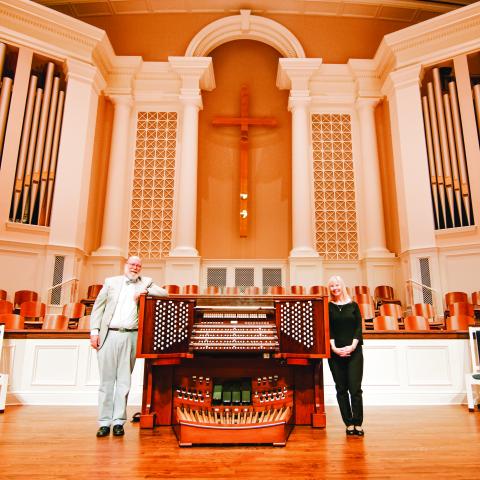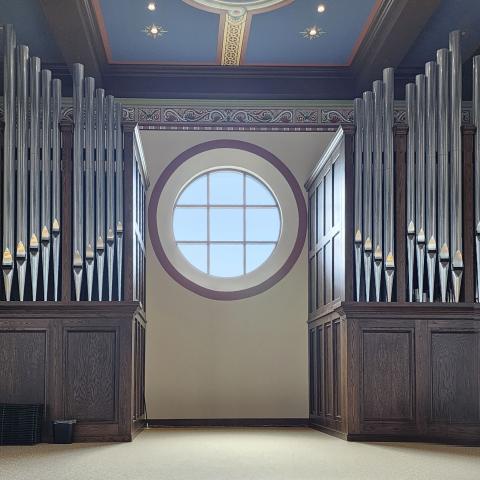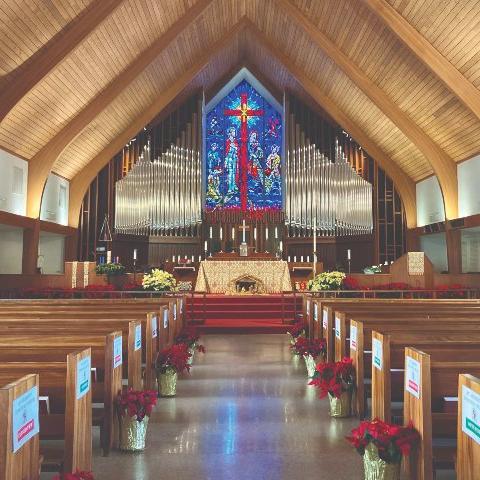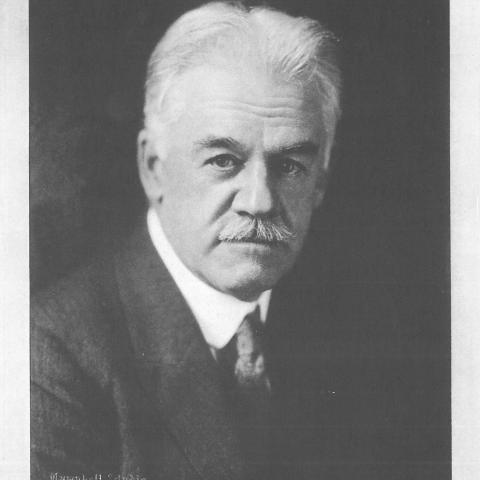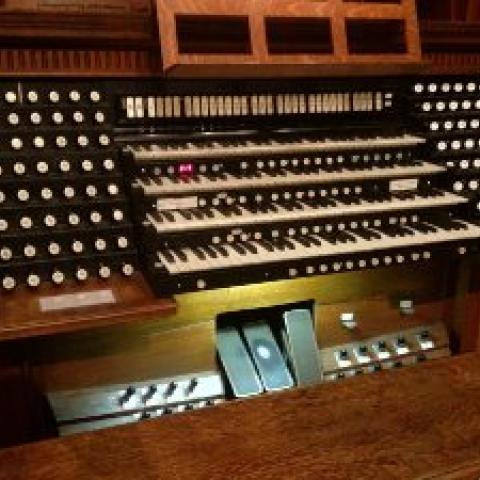Quimby Pipe Organs, Inc., Warrensburg, Missouri
Fifty Years and Counting

Fate, luck, and surprising interactions with others fascinated with the pipe organ were the impetus for the founding of Quimby Pipe Organs, Incorporated, in August 1970. The same scenarios have continued over the years until the company reached its fiftieth birthday this past August 2020.
I was exposed to pipe organs when I was a fourth grader, while my father was accomplishing his residence work on his doctorate in agriculture economics at Oklahoma State University, Stillwater, Oklahoma. I was encouraged by my mother to join the boys’ choir at First United Methodist Church, Stillwater, where Mrs. Ben W. Martin was minister of music. One trip looking into the pipe organ chambers of the 1929 Hillgreen, Lane & Company Opus 959 was all that was necessary to start a dream. This experience paved the way or caused the orange shellac to start to flow as is often quoted. It is said that everyone who is an organbuilder and who passionately loves the pipe organ has orange shellac flowing in their veins.
To me it seemed obvious that an organbuilder should know how to play the instrument and have an understanding of the repertoire. I studied organ under Professors Dr. Frederick W. Homan and Dr. William E. McCandless at the University of Central Missouri, Warrensburg, where I completed bachelor’s and master’s degrees in music.
Today I play the instrument for my own enjoyment and occasionally substitute. I did play for the First United Methodist Church, Warrensburg, for forty years, thankfully with a readily available substitute when I was required to be out of town working on pipe organ projects.
Early influences
My formative years in pipe organ building were significantly influenced by Colin A. Campbell, a service representative for M. P. Möller, and Charles McManis, the legendary pipe organ builder in Kansas City, Kansas.
I started my adventures in organbuilding as a key holder with Mr. Campbell and subsequently was taught to tune before the age of fancy digital tuning devices. Of interest to pipe organ historians, I still have Mr. Campbell’s Peterson tuner, with tubes and only two pitch selections—he modified this function himself for fine tuning the pitch adjustment. Additionally, I learned to leather pouches and primary actions, restore reservoirs, loom cables for windchests and console connections, and to accomplish basic voicing techniques to correct speech problems, basic reed cleaning and regulation, and the basics of cutting up flue pipes, adjusting languids, and the proper use of toe cones. Considerable time was spent in learning how to quickly ascertain technical issues with tuning or on an emergency visit. Mr. Campbell was extremely fastidious regarding the quality of the work accomplished. Since cleanliness and precise order were virtuous in his eyes, he had no patience for instruments that were designed in such a way as to make tuning and maintenance difficult.
In the way that Mr. Campbell influenced my mind as a service technician, Charles McManis also influenced my mind regarding tonal design and flue voicing. He never abandoned voicing techniques such as nicking that were considered an abomination by builders of the Organ Reform Movement. He was never an advocate of voicing flue pipes resulting in a fluty timbre especially in principal chorus ranks. See his book, Wanted: One Crate of Lions—The Life and Legacy of Charles W. McManis, Organbuilder, OHS Press, 2008. In the course of completing my degrees I became intimately acquainted with his Opus 60, 1959, a two-manual electro-pneumatic instrument located in Hart Recital Hall, University of Central Missouri, Warrensburg, Missouri. Two other instruments of his design left a lasting impression on me as well—his two-manual organ installed in South Street Christian Church, Springfield, Missouri, and his three-manual organ installed in Saint John’s United Methodist Church, Kansas City, Missouri.
1970s
This decade was a time of steady growth for QPO with one employee and the active participation of my wife Nancy Elizabeth, since deceased. In 1972, First Christian Church, Warrensburg—upon the recommendation of the UCM organ faculty and Dr. Conan Castle, director of choral activities at UCM and director of music at First Christian—selected QPO to build its Opus 1, a two-manual, 21-rank instrument, on which Charles McManis provided input. Opus 1 retained four ranks from their 13-rank Kilgen (1919), along with the case. The instrument was dedicated in September 1973. Coming up in 2023, Ken Cowan will perform the fiftieth anniversary recital.
Additional work accomplished in the 1970s included the restoration of a splendid two-manual, 14-rank mechanical-action (tracker) instrument by an unknown builder; the relocation of a two-manual, 15-rank Pfeffer tracker; the restoration of a one-manual, 10-rank Kilgen tracker; and the relocation of Möller Opus 5818. Two other two-manual instruments were also built during this decade.
1980s
The 1980s proved to be quite beneficial to the growth of QPO. In 1982 we were appointed curators of the Auditorium Organ, the four-manual, 110-rank Aeolian-Skinner Opus 1309, located in Independence, Missouri, where Dr. John Obetz was the principal organist. This appointment was the launching pad for future work because of the credibility that it gave to a young firm.
From 1985 to 1987 the Auditorium Organ went through an extensive rebuild where the leather throughout the instrument had prematurely failed. The console was also failing due to the extraordinary amount of use that it endured. At this time, it was decided to completely revoice the instrument. The revoicing work was accomplished by John Hendriksen, former head voicer of Aeolian-Skinner, and Thomas H. Anderson, former head of the Aeolian-Skinner pipe shop, who built four new ranks. This project resulted in a long-standing relationship with both John and Tommy. John was not only an excellent flue voicer but was also an artist at knowing the potential of vintage pipework. He was able to change their character by scale changes, changing cut ups, or adding nicking. Through Tommy’s guidance, old pipework could take on a completely new purpose and look.
One of our most pivotal occurrences was being selected as the builder at First United Methodist Church, Fort Smith, Arkansas. Ms. Nancy Vernon, chair of the organ committee, after extensively researching our work, believed in QPO and felt that our young firm would provide them with the best instrument.
In addition to these, fifteen new instruments along with six rebuilds were completed during this decade.
1990s
The 1990s proved to be a pivotal decade. In 1991, I convinced Eric Johnson, who apprenticed with L. W. Blackinton and Associates, to join QPO. Eric brought with him the Blackinton slider chest design, which incorporated a different pallet design, along with other features that eliminated the need for slider seals. These windchests exceeded my expectations and allowed our pipework to be voiced to its full potential by eliminating the explosive attack experienced when using individual pipe valves.
In 1997, Eric, Michael Brittenback, organist of St. Margaret’s Church, Thomas Brown, and myself, embarked on a journey to Europe, led by Jonathan Ambrosino, to study notable English organs of the nineteenth and early twentieth centuries, along with the works of Aristide Cavaillé-Coll. This fact-finding mission was in advance of building our Opus 50 (IV/71) at Saint Margaret’s Episcopal Church, Palm Desert, California, which was designed by Mr. Ambrosino. Also, on that same trip we were fortunate to have Stephen Bicknell and Jean-Louis Coignet offer their expertise. Todd Wilson recorded his CD Frank Bridge and Friends on the instrument at Saint Margaret’s (available on the web).
Ever since that trip, whenever possible, our instruments have an 8′ Diapason in each manual division with developed diapason and reed choruses. This was a radical shift in tonal design from the terraced diapason choruses of McManis. Our thoughts about solo and chorus reeds also evolved significantly. During this trip, Eric and I confirmed the significance of appropriate metal thicknesses for flues and reeds also. Years before I had noticed, quite by accident, how foundational timbre and balance in the overtone series was affected just by holding the body of the pipe. The English and French organs that we studied confirmed the need for heavier metal thicknesses. When I examined a spotted metal 8′ Diapason pipe built by T. C. Lewis, which showed no evidence of collapse, it prompted me to have the metal analyzed, which confirmed the addition of antimony and other trace elements in the metal.
During the 1990s we completed four four-manual, five three-manual, and thirteen two-manual instruments, along with over thirty rebuilds.
2000s
The first decade of the twenty-first century opened with the decision to expand our pipe shop and make and voice our own reeds whenever possible. This change made it possible to differentiate our reeds from that of other builders. Our head reed voicer, Eric Johnson, developed the chorus and solo reeds that we have become noted for their timbre and excellent tuning stability. The first instrument built with our new tonal philosophy was the three-manual, 55-rank organ located in Gano Chapel of William Jewell College, Liberty, Missouri. This organ was especially important to me as I was allowed complete freedom in the design of the instrument to express my own thoughts and creativity. This instrument still holds a special place in my mind, even with the passage of time.
In 2005, QPO was entrusted with the rebuild of the four-manual, 143-rank Aeolian Skinner Opus 150A located in the Cathedral of Saint John the Divine, New York City, following the fire of 2001. The instrument was removed in 2005 and then returned in the early summer of 2008. Its first public use following the fire was on November 30 of the same year. The work was primarily a restoration except for a new replica four-manual console built to AGO standards, solid-state conversion, and the addition of two ranks. All Ernest Skinner windchests from his 1910 Opus 150 remain, with the exception of two unit chests. This job remains the single most demanding and rewarding job to date.
Other notable new instruments include: First Baptist Church, Jackson, Mississippi (V/155); Dauphin Way United Methodist Church, Mobile, Alabama (IV/71); Canyon Creek Presbyterian Church, Richardson, Texas (III/58); Kirkwood Baptist Church, Kirkwood, Missouri (III/43); and First Christian Church, Jefferson City, Missouri (III/46).
2010s
All of the instruments built in the 2010s have proven to be emotionally satisfying to their owners and consultants, when involved. The most challenging projects in this decade were Fourth Presbyterian Church, Chicago, Illinois (V/143), and Dunwoody United Methodist Church, Dunwoody, Georgia (IV/100).
When Eric Johnson and I first visited Fourth Presbyterian, we were astonished that the 1970 Aeolian-Skinner Opus 1516 was not able to effectively accompany congregational singing, even with a substantial Antiphonal division. Not much was heard past the fourth pew other than mixtures and the 32′ reed. The same issues accompanied its predecessor, the 1913 Ernest M. Skinner Opus 210. Leo Sowerby described the E. M. Skinner as a fantastic instrument for accompanying and softer effects, but devoid of a satisfactory ensemble.
We were fortunate to develop a specification, with the assistance of Dr. John Sherer, that could lead congregational singing without being offensive, and, at the same time, perform the vast majority of pipe organ repertoire. The existing tone openings included one that spoke directly into the chancel and another, added by Goulding & Wood Pipe Organ Builders in their 1994 rebuild of the instrument, that spoke directly into the nave. The nave opening proved to be inadequate for optimal tonal egress, so we were able to create a larger opening by removing the solid decorative panels at the top of the case and replacing them with acoustically porous panels on which the original artwork was duplicated. We also designed and built a Positive division in a matching case in the balcony, opposite the main organ. By doing this, we achieved the satisfactory results we had hoped for. Dr. Sherer used the organ of Woolsey Hall, Yale University, as the demarcation point. Dr. Jan Kraybill’s recording, Live in Concert—The Quimby Pipe Organ of Fourth Presbyterian Church, Chicago (found at https://quimbypipeorgans.com/quimby-sound/) provides an excellent presentation.
Dunwoody United Methodist Church did not want a new instrument, but the merger of two instruments from the past. Their desire was to create a new Romantic pipe organ. The instruments selected were 1912 Ernest M. Skinner Opus 195 and 1938 Casavant Opus 1600. The results exceeded my fondest expectations: that no one would be able to determine where repurposed original ranks were assigned in the new tonal specification. The hard surface chancel was a superb sounding board along with the high vaulted ceiling, making the acoustics of the room the best stop on the organ.
Other new instruments from this timeframe include the following: The Church of Saints Andrew and Matthew, Wilmington, Delaware (III/45); Central United Methodist Church, Concord, North Carolina (III/38); All Saints Episcopal Church, Southern Shores, North Carolina (II/18); Saint John’s Episcopal Church, Lafayette, Indiana (III/29); and First United Methodist Church, Athens, Georgia (IV/68).
Looking ahead
Despite Covid-19, the sixth decade for QPO looks to be very exciting. Work in progress includes the rebuild of Skinner Organ Company Opus 323 for Church of the Messiah, Rhinebeck, New York; tonal rebuild of the Schantz organ located in Trinity Episcopal Church, Indianapolis, Indiana; relocation and rebuilding of the IV/50 Skinner Opus 265, with Pedal 32′ Open Wood and Bombarde for Saint Bernard’s Catholic Parish, Madison, Wisconsin; a new IV/55 organ for First Presbyterian Church, Charlotte, North Carolina; and rebuild and enlargement of Austin Opus 1162 located in Hendricks Hall, University of Central Missouri, Warrensburg, Missouri.
To ensure our work continuing well into the future, we have instituted a succession plan, prepared for us by Stinson Attorneys of Kansas City, Missouri. Present associates of QPO are as follows: Melody Burns, Nancy Dyer, Chris Emerson, Charles Ford, Eric Johnson, Kevin Kissinger, Bryce Munson, Michael Quimby, Brian Seever, Dan Sliger, Anthony Soun, Mahoney Soun, Chirt Touch, and Bailey Tucker.
—Michael Quimby
The photos on the cover page, left to right, top to bottom:
˜The Cathedral of Saint Paul, Saint Paul, Minnesota
Saint John’s Episcopal Church, Lafayette, Indiana
Saint Paul’s Episcopal Cathedral, San Diego, California
Photo caption: The Episcopal Church of Saints Andrew and Matthew, Wilmington, Delaware

